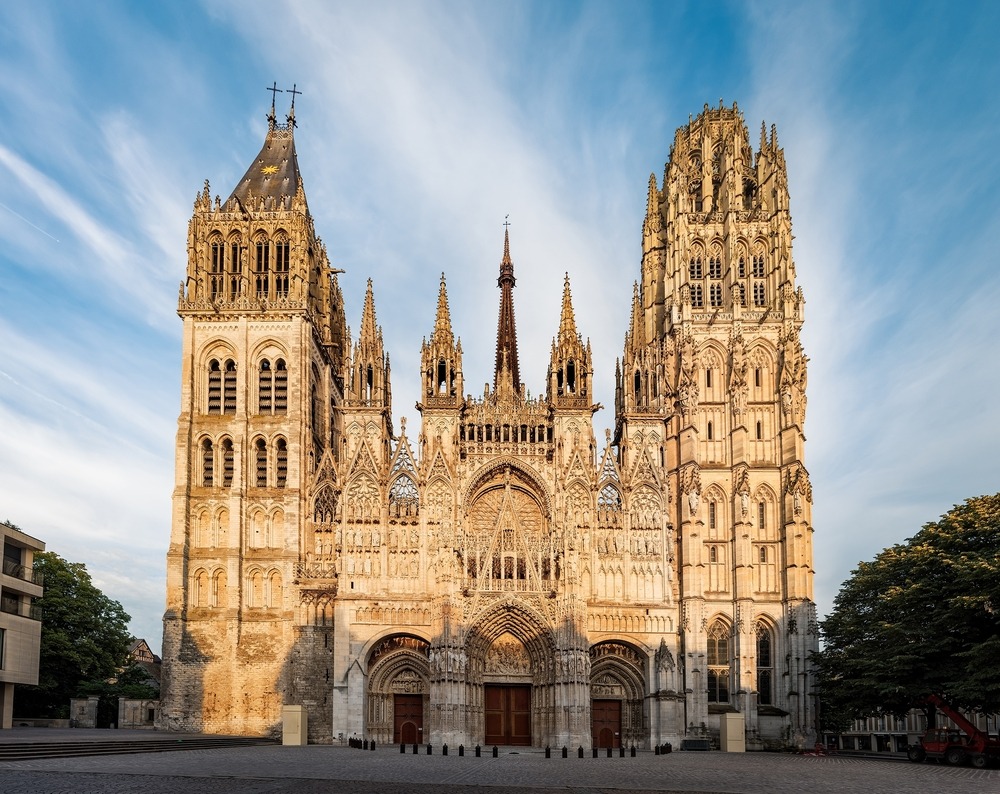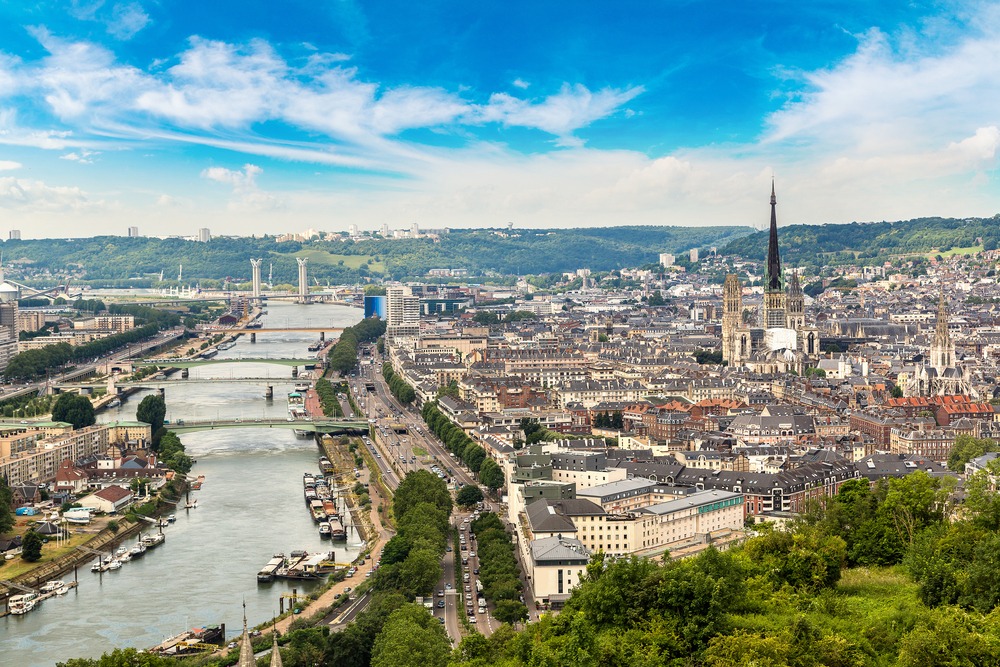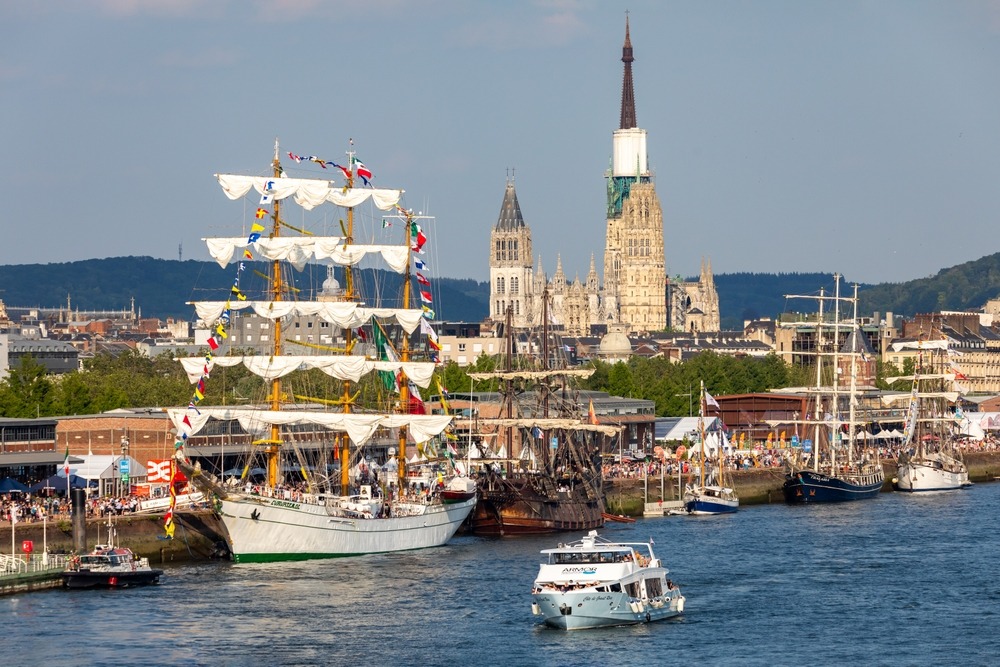Rouen, France: A City of Cathedrals, Kings, and Courage – History and Top 25 Attractions

A DETAILED HISTORY OF ROUEN
Origins and Roman Roots
Rouen, capital of the Seine-Maritime department in the Normandy region, is one of France’s most historically significant cities. It traces its origins to the Gallic tribe of the Veliocasses, who settled along the Seine. The Romans conquered the area in the 1st century BCE, establishing the city of Rotomagus, which became the second most important city in Roman Gaul after Lyon. Roman Rouen was adorned with baths, an amphitheater, a forum, and aqueducts, all benefiting from its strategic river location.
Medieval Rise and Viking Occupation
Following the fall of the Western Roman Empire, Rouen was seized by the Franks and became a bishopric in the 4th century. It grew in influence throughout the Merovingian and Carolingian periods. However, in 841 CE, Viking raids brought chaos. By 911, the region was ceded to the Viking leader Rollo, who became the first Duke of Normandy under the Treaty of Saint-Clair-sur-Epte. Rouen thus became the capital of the Duchy of Normandy.
Under Norman rule, Rouen flourished as a center of commerce, shipbuilding, and religious power. It was in Rouen that William the Conqueror, Duke of Normandy, prepared his invasion of England in 1066.
Capetian France and the Hundred Years’ War
By the early 13th century, King Philip II of France reclaimed Normandy from English control, but during the Hundred Years’ War, Rouen again fell to the English in 1419. The city is most famously associated with the trial and execution of Joan of Arc. In 1431, after a highly politicized ecclesiastical trial held in Rouen, she was condemned as a heretic and burned at the stake in the Place du Vieux-Marché. Her rehabilitation trial took place in the same city decades later.
Renaissance and Religious Conflict
Rouen enjoyed prosperity during the Renaissance. It became a key hub of textile production, particularly in wool and silk. Its port also thrived, and the city grew in architectural beauty. However, the French Wars of Religion brought turmoil. Protestant (Huguenot) forces controlled Rouen briefly before royal Catholic forces recaptured it.
17th–18th Centuries: Cultural Growth and Maritime Power
In the 17th century, Rouen became one of the largest cities in France and a beacon of culture and architecture. Despite some economic decline due to competition from other ports, it remained a vital link in Atlantic and European trade networks. It was also a center for classical education, printing, and art.
19th Century and Industrialization
The Industrial Revolution saw Rouen transition into a manufacturing powerhouse, especially in textiles and metallurgy. The railway linked it directly to Paris, boosting commerce. The city also attracted artists and writers, including Gustave Flaubert, born in Rouen in 1821, who became one of France’s greatest novelists.
World War II and Reconstruction
Rouen suffered considerable damage during World War II, particularly in 1944 during Allied bombings aimed at dislodging German occupation. Many historic buildings were damaged or destroyed, but the city’s spirit endured. Extensive post-war restoration has returned Rouen to its medieval grandeur while integrating modern infrastructure.
Today: A Living Tapestry of History and Culture
Today, Rouen is a dynamic city where Gothic spires meet modern arts, where ancient streets echo the footsteps of saints, kings, and revolutionaries. It retains its status as a religious and cultural capital and welcomes visitors with its blend of medieval charm, riverfront beauty, and Norman pride.

TOP 25 ATTRACTIONS IN ROUEN
1. Rouen Cathedral (Cathédrale Notre-Dame de Rouen)
A masterpiece of French Gothic architecture, this cathedral features a façade famously painted by Claude Monet. Construction began in the 12th century, and its spire, completed in the 19th century, makes it one of the tallest church buildings in France.
2. Gros-Horloge (Great Clock)
An iconic Renaissance astronomical clock set in a 14th-century archway spanning Rue du Gros-Horloge. Its golden dial and ornate details make it a signature of Rouen.
3. Church of Saint Joan of Arc (Église Sainte-Jeanne-d’Arc)
Built in 1979 in Place du Vieux-Marché, this modern church honors the saint and stands near the site where Joan of Arc was executed. Its interior features stunning stained-glass windows from a destroyed 16th-century church.
4. Place du Vieux-Marché
The historic square where Joan of Arc was martyred in 1431. Now lined with cafes and shops, it remains a deeply symbolic site.
5. Musée des Beaux-Arts de Rouen
One of France’s premier regional museums, it houses a vast collection of works from the Renaissance to modern times, including paintings by Monet, Rubens, Delacroix, and Caravaggio.
6. Tour Jeanne d’Arc (Joan of Arc’s Tower)
The only remaining part of Rouen Castle, where Joan of Arc was imprisoned and interrogated. Now a small museum with multimedia exhibits.
7. Rue du Gros-Horloge
A bustling pedestrian street running from the cathedral to the old market square, filled with shops, restaurants, and historic architecture.
8. Church of Saint-Maclou
A stunning example of Flamboyant Gothic architecture, known for its intricate façade and beautifully sculpted doors. It sits near the Aître Saint-Maclou ossuary.
9. Aître Saint-Maclou
A former medieval plague cemetery turned ossuary, this eerie and fascinating site features skull and bone carvings on wooden galleries and now houses a fine arts school and exhibit space.
10. Saint-Ouen Abbey Church (Abbatiale Saint-Ouen)
A majestic Gothic abbey with soaring vaults and a monumental organ. It is nearly as large as the cathedral and renowned for its light-filled nave.
11. Historial Jeanne d’Arc
An immersive museum in the Archbishop’s Palace that uses multimedia displays to recount the life, trial, and legacy of Joan of Arc.
12. Seine River Quays
The redeveloped quays offer walking paths, cafes, and public art installations. River cruises offer perspectives of the city and the surrounding Normandy landscape.
13. Musée Le Secq des Tournelles
A unique museum dedicated to wrought ironworks from the Middle Ages to the 19th century. Housed in a deconsecrated Gothic church, the setting is as intriguing as the artifacts.
14. Musée de la Céramique
This museum showcases Rouen’s rich legacy of faience (tin-glazed pottery), along with European ceramics from the 16th through 19th centuries.
15. Jardin des Plantes de Rouen
A beautifully landscaped botanical garden featuring rare plants, glasshouses, and themed gardens. A peaceful green escape.
16. Palais de Justice
One of the finest Gothic civic buildings in France. It was the seat of the Parliament of Normandy and still bears visible scars from WWII bombings.
17. Rue Eau de Robec
A picturesque street with old water mills, art studios, and half-timbered houses running alongside a stream—less touristy and perfect for a quiet stroll.
18. Panorama XXL
A large rotunda on the banks of the Seine offering 360° immersive exhibitions by artist Yadegar Asisi. Subjects include historic and biblical panoramas.
19. Tour Saint-André
One of the towers from a former church destroyed during WWII, left standing as a war memorial and vantage point over the old town.
20. Lycée Pierre-Corneille
A historic school once attended by French playwright Pierre Corneille, whose 17th-century birthplace is also a museum in the city.
21. Rue Saint-Romain
Lined with antique shops, art galleries, and historic houses, this atmospheric street links many of Rouen’s top attractions.
22. Château de Robert le Diable (nearby)
Located just outside Rouen, this 11th-century hilltop castle ruin offers dramatic views and a connection to Normandy’s ducal history.
23. La Couronne Restaurant
Founded in 1345, this is one of the oldest inns in France. It was here that Julia Child had the meal that inspired her culinary career. The menu is a tribute to traditional Normandy cuisine.
24. Armada de Rouen (event)
Held every few years, this international maritime festival brings tall ships and naval vessels from around the world to the city’s riverbanks, drawing thousands of visitors.
25. Rouen’s Christmas Market and Festivals
The holiday market fills the squares with light, food, crafts, and music, while Rouen also hosts events like the Normandy Impressionist Festival, linking it with its artistic heritage.

Rouen is a city that lives and breathes history—from Roman conquest and Viking dukes to the canonization of saints and the artistry of the Impressionists. With its soaring cathedrals, timbered façades, dynamic museums, and a river that has borne centuries of commerce and culture, Rouen is more than a destination—it’s a storybook brought to life. Whether you’re drawn by Joan of Arc’s legacy, Monet’s light-drenched landscapes, or the taste of Norman cider in a centuries-old inn, Rouen invites you to walk its streets and discover its soul.

































